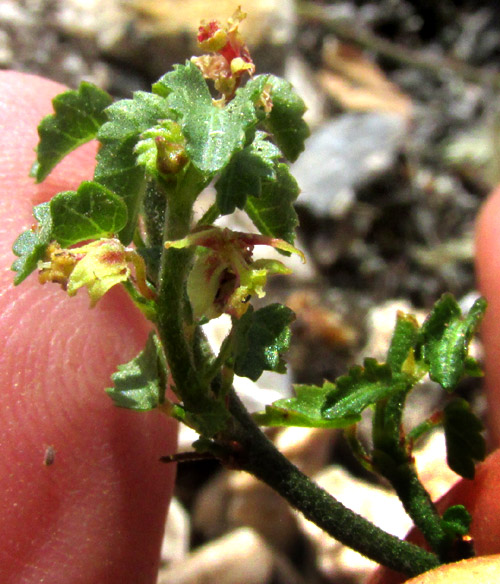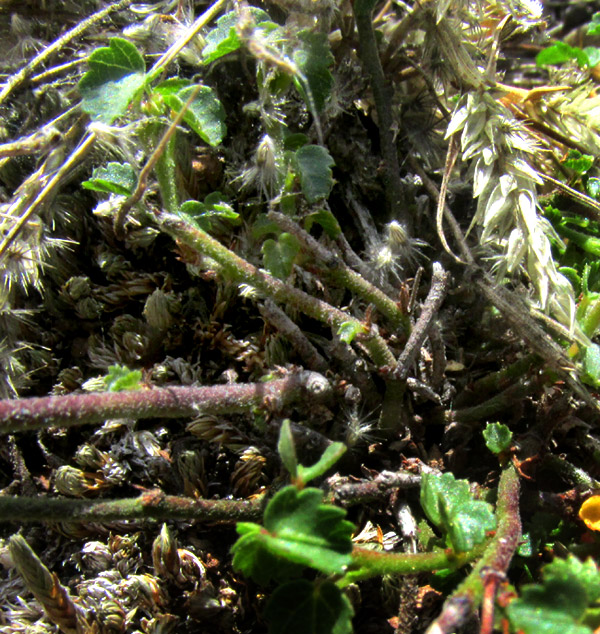Excerpts from Jim Conrad's
Naturalist Newsletter
Entry dated March 9, 2024, from notes taken about 2kms west of Higuerillas, Municipality of Cadereyta de Montes; N20.9086°, W99.7865°, elevation ~1760 meters (~5760 feet); on greywacke sandstone cap of hill; area constituting a narrow belt of the extreme southern extension of the Chihuahuan Desert, Meridional Subregion; central Querétaro state, MÉXICO
AYENIA COMPACTA

Atop a windswept, sunbaked hill, the above rigidly straight stem sprouted new leaves and flowers despite the North American Drought Monitor categorizing this area as experiencing a D3 Extreme Drought. The stem hugged the ground, which was a good strategy here where so many hungry feral burros roamed around. The semiwoody little shrub grew amid tufts of Nineawn Pappusgrass, which researchers in Africa have described as a pioneer species tolerating overgrazing, and occurring in dry, calcareous soils -- a characterization fully applying here.
The stem was just one of several radiating from a base rooted in thin, gravely soil atop an outcrop of white, crystalline sedimentary rocks known as evaporites. This evaporite outcrop was formed during the geologically ancient evaporation of water bearing dissolved mineral salts such as sodium and calcium. Up close, the flowers were astonishing:

It took some studying to recognize that the yellowish green blossom bottom part was a typical calyx consisting of five spreading, narrowly triangular sepals. The corolla consisted of five petals shaped like ping-pong paddles whose handles were far too long, far too slender, and curved. From below, the handles -- better known as claws -- curved outward, then upward, then toward the flower's center, where they widened into the paddles' broad hitting surfaces. Because nearly all of the blossom is yellow-green, it's hard to see that the tips of the petals' broad parts are fissured or cleft. At the base of each lamina cleft there arises, amazingly, a blackish, fingerlike "appendage," swelling toward the top and pointing upward. Normally five appendages would be seen but possibly the above blossom is still in the act of opening up, for several of its parts aren't exactly in position. At the flower's left there's a flower bud about to open.

In the above picture, a sepal hides one of the flower's most distinctive features: arising from the center of the calyx, there's a slender, stalk-like staminal tube (sometimes referred to as the androgynophore), atop which the male and female parts come together. The petals' broad parts create a kind of ceiling suspended atop five curved claws, meeting the top of the staminal tube.
On Aaron Schusteff's 2019 Ayenia compacta web page at the University of California, Berkeley CalPhotos website, Schusteff describes writes: "... the apex of each petal blade overlaps onto the upper rim of the staminal tube, and the small flaps of each notched petal-tip clasp the rim of staminal tube, fitting snugly around the base of the short free filaments below them, with the corresponding anther tucked under the petal tip." As of that writing in 2019, the manner by which all this complicated structure encouraged pollination wasn't known, though it was clearly a story waiting to be told.

As judged by my fingertip on the picture's left side, the newly unfurled leaves were still quite small. They arose in pairs opposite one another on stems, and each blade margin developed five or so conspicuous teeth. In the picture the blades appear hairless and possibly somewhat resinous. Below, you can see the plant's base with several stems arising at the center and spreading outward.

This plant's flowers reminded me most of those seen on a very spiny bush encountered in the Yucatan, Ayenia aculeata. Since that species belongs to the genus Ayenia, famous for its tiny, complex flowers, that's where I looked first.
Ayenia belongs to the Byttnerioideae Subfamily of the Hibiscus Family, the Malvaceae. In this upland region of central Mexico known as the Bajío, around 76 species have been documented belonging to that subfamily, which during most of my life has been recognized as a distinct family, the Chocolate Family, the Sterculiaceae. About nine Ayenia species are documented for this region. Of those nine species, if your flowers' petals bear a blackish, fingerlike appendage pointing upward, and only one or two, maybe three flowers appear in each flower cluster, you have one of two species. These species are so alike that with pictures I can't tell them apart. I suspect that eventually they'll be lumped into the same species.
The Flora del Bajío distinguishes them by saying that one, Ayenia compacta, bears diminutive, branched hairs (stellate) but that the plant's surface is "glabrescent," which means that it tends to become hairless or maybe actually is hairless. The other species, Ayenia pilosa, also is "glabrescent," but its tiny hairs, which may or may not be there, aren't branched.
Of those two species, because only one is documented in the Flora del Bajío as occurring in our general area -- in fact, exactly at the location our plant now grows -- I'm filing our plant here under the name AYENIA COMPACTA, known by no English name.
Ayenia compacta mainly lives in Mexico's Baja California, though the species extends across the border into the US's southern California and Arizona, plus here in the central Mexican uplands there are several accounts of another population, apparently disjunct. Most images of Ayenia compacta flowers portray them as pale pinkish, while our flowers' petals are pale yellowish green. The Flora del Bajío is silent on petal color, though it says that the sepals are rosy or red. Also, it appears that the staminal tube on our flowers are shorter than those in photos taken in their main distribution area. Could these differences result from our flowers being so young, or as a consequence of the drought, or maybe because they're a different species?
Who would have thought that such a ragtag-looking, low-lying stem, upon inspection, might be so pretty, and so puzzling?